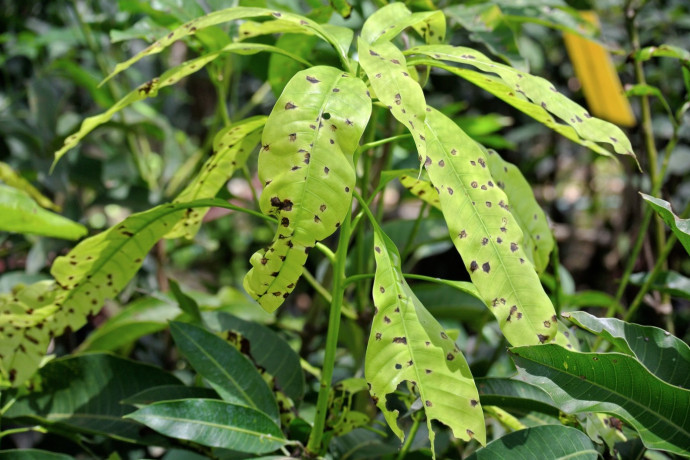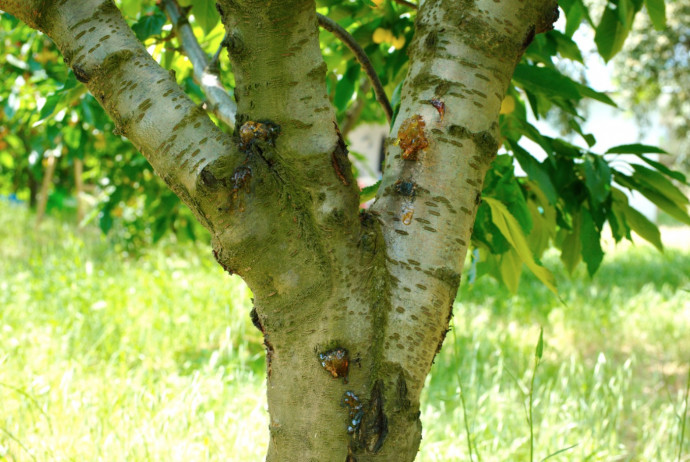1. Anthracnose

This is one of the most common diseases affecting trees in North America. Some tree species are more at risk, such as Modesto ash and American sycamore, so look for resistant varieties. Fungal infection affects foliage, flowers, fruit, and branches of trees and shrubs.
Symptoms depend on the tree species affected, but leaf drop and dense shoot growth are possible signs of anthracnose. Treatment for anthracnose includes removing dead twigs, branches and infected leaves. The next step is to apply a copper-based fungicide.
2. Dothistroma Needle Blight

In this rot, pine needles turn brown at the tips. Gradually, the entire needle turns brown and falls off. Dothistroma needle rot can be fatal and is most common in Austrian pine and ponderosa pine. Preventive measures include good air circulation by avoiding dense crowding, mulching trees, and watering at the base to avoid wetting the foliage. A fungicide can also be used.
3. Apple Scab

Apple scab is a disease that affects apple and crabapple trees. As the name suggests, the fungal infection produces lesions with a scab-like appearance on leaves and fruit. Although apple scab is not a serious disease, it can still cause a tree to look unsightly and shabby. Over time, an infected tree may also lose all of its leaves, causing stress that can make the plant susceptible to other diseases.
Treatment for apple scab involves controlling the fungus and its spread by removing and raking off dead, infected foliage. If the infection is severe, apply a fungicide early in the season to protect newly emerging leaves. Fungicides are not a cure for apple scab, but they can prevent further damage to a tree and neighboring healthy plants. Ultimately, however, prevention is the best option. To avoid the disease, plant only disease-resistant varieties.
4. Canker diseases

Canker diseases can be fungal or bacterial in origin. Cankers can cause severe structural damage to trees, weakening them so much that branches break easily. These elongated lesions often have a reddish tinge and can affect branches, twigs or trunks.
As with apple scab, the best medicine for canker is prevention. Choosing disease-resistant and native varieties will ensure the trees' success. To prevent the spread of disease in an infested tree:
1. remove diseased branches or twigs.
2. Do not prune in wet weather as this can promote the spread of the fungus.
3. Call a professional for help if a tree has a large canker in the trunk area.
5. Cedar-Apple Rust

This type of fungal infection does not kill a tree, but can severely weaken it. It affects two specific types of trees: eastern red cedars and apple trees. Growths on eastern red cedars develop and release fungal spores that then infect apple trees, causing leaf damage and hindering fruit production.
Removing the growths, called juniper galls, that spread the spores is one way to control the spread of the fungus. Preventive spraying with fungicides, liquid copper or bio-fungicides - especially if the disease is prevalent in your area - can prevent the spores from infecting apple trees.
If apple trees are already showing signs of cedar apple rust, it's no longer possible to control the fungal infection. The only thing left to do then is to remove infected leaves to prevent the fungus from spreading again. Other preventive measures include avoiding planting juniper species near apple trees and planting disease-resistant varieties.
6. Diplodia tip rot

This fungal disease primarily affects mature conifers. Infections are more likely in trees that have experienced some form of stress, whether due to poor soil or adverse weather conditions. The disease produces very small black growths that appear on needles and pine cones. These growths eventually spread fungal spores, so removing them can prevent the spread of the disease.
Treatment with fungicides is effective for this type of infection. The best time to spray is in the spring when the buds begin to sprout.
7. Fire Blight

Fire blight primarily affects apple and pear trees. The bacterial infection first attacks the blossoms and eventually causes cankers and rapidly wilting shoots. As with other types of fire blight, there is no cure for fire blight. To prevent the spread of the disease, remove cankers when the plant is dormant. Pruning affected stems and branches will also help control it. Bacterial sprays can help prevent the survival and spread of the bacteria. However, there is no guarantee that spraying your tree with chemicals will fix the problem.
8. Oak Wilt

Oak wilt is a fungal disease that is specific to oaks. It is fatal to species in the red oak group (pointed leaf lobes), while species in the white oak family (round leaf lobes) are less susceptible. Starting at the top of the tree, the leaves quickly wilt and turn brown. Oak wilt is transmitted from tree to tree through the roots of one oak to another, or by sap-sucking beetles attracted to freshly cut wood. Avoid pruning oaks during the growing season. If you must prune an oak during the growing season, use a wound sealant to make the wound less attractive to beetles. Proper care of your oaks will ensure spectacular fall color.










What do you suggest for curly leaf disease on peach trees